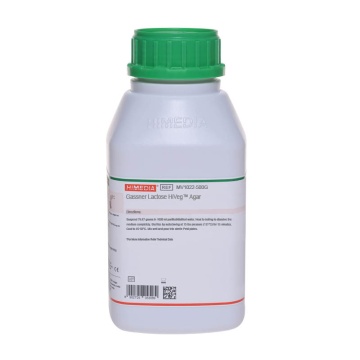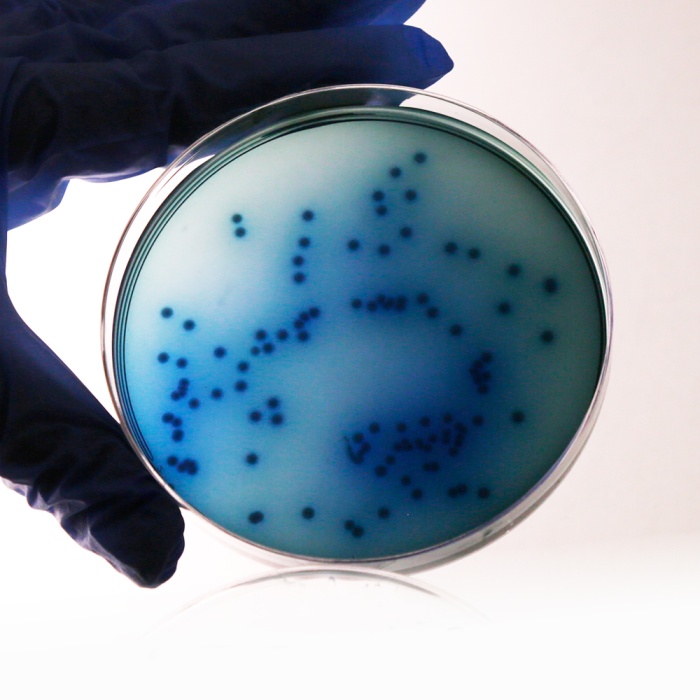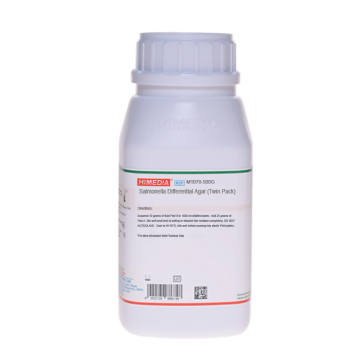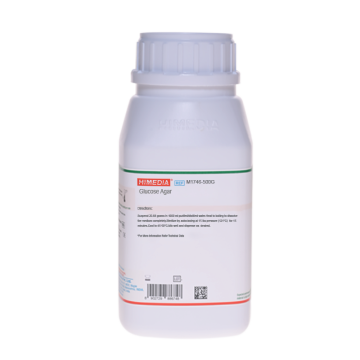 Your enquiry has been submitted
Your enquiry has been submitted
Gassner Lactose Agar
Salmonella#CC293D
Intended Use
Recommended for detection and isolation of pathogenic Enterobacteriaceae from food stuffs and other materials.
Composition
| Ingredients | g/L |
|---|---|
| HM peptone # | 7.000 |
| Sodium chloride | 5.000 |
| Lactose | 50.000 |
| Metachrome yellow | 1.250 |
| Water blue | 0.625 |
| Agar | 13.000 |
Final pH (at 25°C): 7.2±0.2
**Formula adjusted, standardized to suit performance parameters
# Equivalent to Meat peptone
Directions
Suspend 76.87 grams in 1000 ml purified/distilled water. Heat to boiling to dissolve the medium completely. Sterilize by autoclaving at 15 lbs pressure (121°C) for 15 minutes. Cool to 45-50°C. Mix well and pour into sterile Petri plates.
Principle And Interpretation
Gram-negative bacilli belonging to Enterobacteriaceae are widely dispersed in nature and have been frequently isolated from clinical specimens. The genera in Enterobacteriaceae include pathogens such as Salmonella, Shigella, Yersinia, diarrheogenic E.coli and others. Definitive identification of members of Enterobacteriaceae may require a battery of biochemical tests. Differentiation of the Enterobacteriaceae however is based primarily on the presence or absence of different enzymes coded by the genetic material possessed. These enzymes direct the metabolism of bacteria along one of several pathways that can be detected in vitro. Substrates on which these enzymes can react are incorporated into the culture medium together with an indicator that can detect either utilization of the substrate or the formation of specific metabolic products.
Gassner Lactose Agar was originally developed by Gassner for the detection and isolation of pathogenic Enterobacteriaceae from food and other materials (1). This medium has been prescribed in the regulations for the execution of the German Meat Inspection Law (Deutsches Fleischbeschaugesetz) (2).
This medium is also known as Water-blue Metachrome-Yellow Lactose Agar. Metachrome-yellow primarily inhibits gram-positive microorganisms present in the food materials. Lactose fermenters produce acid, indicated by the water blue indicator, which turns blue in acidic range and colourless in the alkaline range. Original colour of the prepared medium is green, but in the acidic pH it becomes blue-green to blue while in the alkaline conditions the yellow colour of metachrome yellow becomes increasingly apparent. Medium ingredients like HM peptone provide essential nutrients and sodium chloride maintains osmotic balance respectively.
Type of specimen
Food samples; Water samples
Specimen Collection and Handling:
For food samples, follow appropriate techniques for sample collection and processing as per guidelines (3). For water samples, follow appropriate techniques for sample collection, processing as per guidelines and local standards.(4)
After use, contaminated materials must be sterilized by autoclaving before discarding.
Warning and Precautions :
Read the label before opening the container. Wear protective gloves/protective clothing/eye protection/ face protection. Follow good microbiological lab practices while handling specimens and culture. Standard precautions as per established guidelines should be followed while handling specimens. Safety guidelines may be referred in individual safety data sheets.
Limitations :
- Other biochemical tests must be carried for confirmation.
Performance and Evaluation
Performance of the medium is expected when used as per the direction on the label within the expiry period when stored at recommended temperature.
Quality Control
Appearance: Light yellow to green homogeneous free flowing powder
Gelling: Firm, comparable with 1.3% Agar gel.
Colour and Clarity of prepared medium: Dark green coloured, clear to slightly opalescent gel forms in Petri plates
Reaction: Reaction of 7.69% w/v aqueous solution at 25°C. pH : 7.2±0.2
pH: 7.00-7.40
Cultural Response: Cultural characteristics observed after an incubation at 35-37°C for 18-48 hours.
| Organism | Inoculum (CFU) | Growth | Recovery | Colour of colony | Colour change of medium |
|---|---|---|---|---|---|
| Enterococcus faecalis ATCC 29212 (00087*) | >=104 | inhibited | 0% | ||
| Escherichia coli ATCC 25922 (00013*) | 50-100 | good-luxuriant | >=50% | dark green | blue |
| Klebsiella pneumoniae ATCC 13883 (00097*) | 50-100 | good-luxuriant | >=50% | mucoid green | blue |
| Proteus mirabilis ATCC 25933 | 50-100 | good-luxuriant | >=50% | yellowish green | yellow |
| Salmonella Typhi ATCC 6539 | 50-100 | good-luxuriant | >=50% | yellow | yellow |
| Salmonella Typhimurium ATCC 14028 (00031*) | 50-100 | good-luxuriant | >=50% | yellow | yellow |
| Salmonella Enteritidis ATCC 13076 (00030*) | 50-100 | good-luxuriant | >=50% | yellow | yellow |
| Shigella flexneri ATCC 12022 (00126*) | 50-100 | good-luxuriant | >=50% | yellow | yellow |
| Staphylococcus aureus subsp. aureus ATCC 25923 (00034*) | >=104 | inhibited | 0% |
Key: *Corresponding WDCM numbers.
Storage and Shelf Life
Store between 10-30°C in a tightly closed container and the prepared medium at 20-30°C. Use before expiry date on the label. On opening, product should be properly stored dry, after tightly capping the bottle in order to prevent lump formation due to the hygroscopic nature of the product. Improper storage of the product may lead to lump formation. Store in dry ventilated area protected from extremes of temperature and sources of ignition. Seal the container tightly after use. Product performance is best if used within stated expiry period.
Disposal
User must ensure safe disposal by autoclaving and/or incineration of used or unusable preparations of this product. Follow established laboratory procedures in disposing of infectious materials and material that comes into contact with sample must be decontaminated and disposed of in accordance with current laboratory techniques (5,6).
Reference
- Gassner G., 1918, Centralbl. F. Bakt. I. Orig., 80:219-222.
- Deutsches Fleischbeschaugesetz: Anlage 1 zu § 20 Abs. 4: Vorschriften über die bakteriologische Fleischuntersuchuang.
- Salfinger Y., and Tortorello M.L., 2015, Compendium of Methods for the Microbiological Examination of Foods, 5th Ed., American Public Health Association, Washington, D.C.
- Lipps WC, Braun-Howland EB, Baxter TE,eds. Standard methods for the Examination of Water and Wastewater, 24th ed. Washington DC:APHA Press; 2023.
- Isenberg, H.D. Clinical Microbiology Procedures Handbook 2nd Edition.
- Jorgensen, J.H., Pfaller, M.A., Carroll, K.C., Funke, G., Landry, M.L., Richter, S.S and Warnock., D.W. (2015) Manual of Clinical Microbiology, 11th Edition. Vol. 1.
| Product Name | Gassner Lactose Agar |
|---|---|
| SKU | M1022 |
| Product Type | Regular |
| Physical Form | Powder |
| Origin | Animal |
| Packaging type | HDPE |
| References | 1.Gassner G., 1918, Centralbl. F. Bakt. I. Orig., 80:219-22 |
| Customized Product Available | No |











